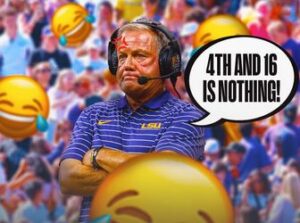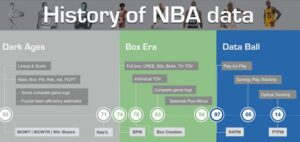Podcast: Play in new window | Download
Subscribe: RSS
On Monday night, the Las Vegas Raiders scored a touchdown with four minutes to go in the game and trailed Kansas City 30-29. An extra point would have tied the game and, at the least, given the Raiders a chance to play in overtime against the home town Chiefs.
Instead, Raiders Head Coach Josh (I’m much better as an assistant coach) McDaniels played the analytics card. By going for a two-point conversion, the Raiders (if successful) would take a one-point lead and force Kansas City to score with four minutes remaining in the game.
Of course, the two point conversion failed. Final Score: Kansas City 30, Las Vegas 29.
Someone has a lot of ‘splaining to do out in Raider Nation!
As a person whose daughter-in-law has a Ph.D. in the field of statistics, you might think that I would be squarely on the side of the stat generators.
In some matters, I am. Knowing whether the statistics are in your favor is a wise thing to consider in many decisions. When it comes to most major sports, though, I am having serious doubts.
Here’s a good analogy.

Though I’m sure that modern jets have a quite competent automatic pilot mechanism to guide the craft through the open skies, I prefer knowing that my pilot’s years of experience (along with an alert brain and skilled hands) are helping to land the airplane safely at its destination.
Let’s define the term analytics as it applies to sports.

Sports analytics is an emerging field which applies data analysis and statistical techniques to analyze various components of a particular sport. It relates to decisions made concerning player performance, on-field decision making, player recruitment and more.
It is becoming a rather lucrative career in recent years. One recruiting service indicated that the national average salary for Sports Analytics jobs is now $93,000 per year.
Major League Baseball has been a leading proponent of analytics in its games for more than a decade.
You have seen baseball players shifting around on the field (at least through the end of this season). There is a reason why they do it. Statistics show that the opposing team’s slugger Big Beef McGuirk rarely hits the ball to the right side of the field.

You can also blame analytics for the parade of one-inning relief pitchers which have been causing baseball games to take even longer to play than ever. Apparently the statistics show that trotting out four or five pitchers during a nine-inning baseball game yields more success than one primary starting pitcher and, if needed, one or two relief pitchers to finish the game.
Yes, statistics don’t lie. While that may be true, your team’s coach is being paid millions to make observations and adjustments as the team leader.
If slugger Beef McGuirk (a career .250 hitter) has been batting .450 over the last few weeks, perhaps it might be a good idea if his coach left him in the game to bat against the other team’s fifth relief pitcher in the bottom of the 9th inning. Though ol’ Beef might normally be a bad statistical bet to bring home the winning run, his recent hot hitting streak defies logic and the analytics “book”.
Sometimes the coach must override the stat book and trust his experience and instincts.
Though baseball may be the current sports king of analytics, golf is another sport where statistical analysis has been on the increase for several years.
Fifty years ago, golf stats were limited to simple things such as longest drives (measured at a couple of holes by a young person who would run onto the golf course with a tape measure to estimate the distance). Putting statistics were simply counting putts made vs. total putts attempted.

Today’s golf statistics will make your head spin.
Did you know that the PGA Tour now keeps a statistic entitled “Good Drive Percentage”? I thought a good drive is what you said to a golfer when he kept the ball in the fairway! Not anymore! There is a new stat for that today.
Here is the definition of how to determine a “Good Drive” in 2022: “On Par 4 and Par 5’s, the number of fairways hit, plus the number of greens or fringe in regulation when the drive was not in the fairway on the tee shot divided by the number of par 4 and par 5’s played.”
Today’s professional golfers (men and women) are bombing juiced golf balls as far as they can. Regardless of whether the ball ends-up in the fairway (a good thing), the off-fairway slugger is now being rewarded if he or she is still able to get the golf ball onto the putting surface in regulation.
I’d prefer to call this the “Tiger-in-the-Woods” stat!

Football is now getting more and more involved with statistics and analytics.
Some high school football coaches have stopped punting the ball altogether. They have become enamored with statistics which favor running another play on fourth down rather than punting the ball to the opposing team. Going against the grain takes a lot of guts for the coach. The coach must be able to withstand the pressure from the team’s supporters and employer, too.
On Saturday in Baton Rouge, LSU Coach Brian Kelly was asked to explain why his Tigers opted to go for it on fourth down (rather than punt the ball) on three different occasions. In each case, LSU failed to convert a fourth down attempt and turned the ball over to Tennessee (which won the game 40-13).

Why did the coach opt to go for it in those situations? Analytics, of course!
Here is what Coach Kelly said after the game, “Got behind by 10, and then couldn’t match possessions at that time. We were within the analytical numbers too, so I was keeping an eye on where we were from that position. I felt like we had to make something happen in those situations. (The fourth and 10) was a go in our (analytics) book.”
Anyone watching the football game would agree with LSU’s coach that the Tigers were in dire need of making something happen rather than punting the football to Tennessee.
However, you can’t blame your own bad decisions with solid analytics to justify your mistakes, either.
LSU’s football coach is being paid $9 million per year to make his own decisions based on years of experience. I commend Coach Kelly for taking the statistics into account, but he is being paid to utilize his own instincts and experience to make the final call in a difficult situation.
By failing on each of three fourth-down plays, Tennessee capitalized and tacked on even more points during this SEC rout. As a result, the new LSU coach’s reliance on analytics turned into the worst loss (27 points) in Brian Kelly’s 17-year major college career.
On Monday night in Kansas City in front of ESPN’s nationwide audience, the Las Vegas Raiders dropped to 1-4 and the bottom of the AFC West with a very questionable extra-point decision based on situational analytics.
Did you know that there is something called ESPN Analytics? Yes, data scientists are now being employed by most major sports teams and even the broadcast networks. A few years ago, ESPN published a list of teams in major sports and how much (or little) they are invested in analytics.

The list produced mixed results. Some of the top teams in sports (baseball’s Houston Astros and the NBA San Antonio Spurs) fully embrace analytics within their organization. However, other teams are either on the fence or don’t feel the need to spend the time and money on it.
Most statistics utilized during today’s television broadcasts add little to my enjoyment of the on-field product. I think that these stats are being used to entertain some of the most easily bored sports fans to keep them tuned in for longer stretches and watch more commercials.
Last Saturday in Baton Rouge, I only needed one statistic to confirm that LSU was getting their butt kicked by Tennessee on the football field. The score.
Analytics and data science has become a convenient excuse to justify a coach’s poor decisions in defeat. I invite you to please let me know when you finally hear the winning coach say, “If we hadn’t have relied on the analytics, we wouldn’t have won that ball game!”
I won’t hold my breath.
At the rate which analytics has overtaken sports, perhaps it’s time to save money on expensive head coaches. Let’s turn the team over to Coach Uniblab!

